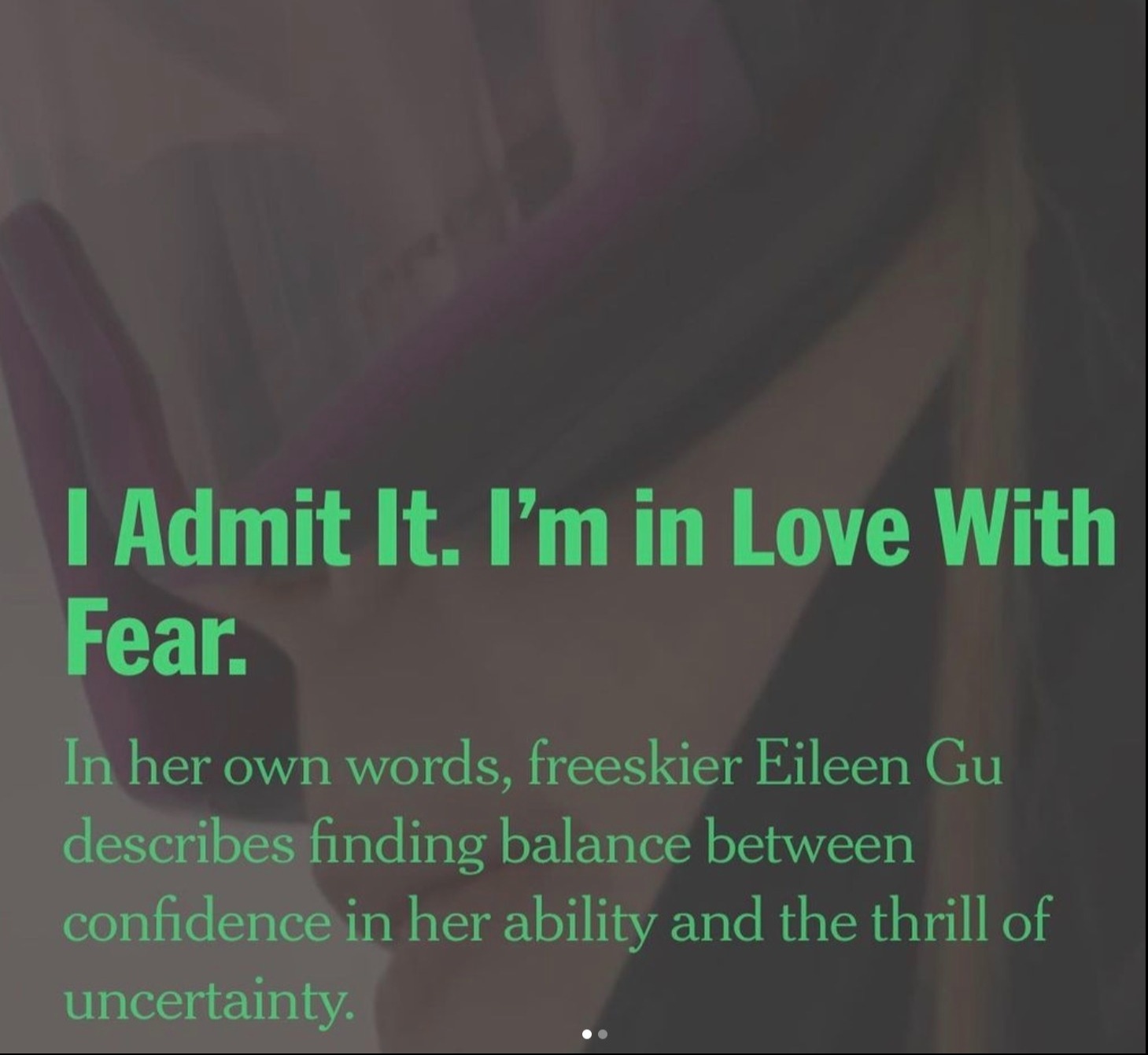
近日,自由式滑雪归化运动员谷爱凌在美国知名媒体《纽约时报》上发布了一篇亲笔长文,以一位青年女运动员的视角讲述了她在从事极限运动时“与恐惧打交道”的心路历程。本文将转载这篇文章的英文原文。
谷爱凌已经于北京时间2月8日为中国队夺得冬奥会自由式滑雪女子大跳台项目的金牌,之后她还将参加坡面障碍技巧和U形场地两个小项的比赛。
I Admit,I‘m In Love With Fear
Essay by Eileen Gu
FOR THE LAST 10 OF MY 18 YEARS, I’ve pursued a tumultuous love affair with fear. I’m a professional freeskier, and twin-tipped skis, 22-foot halfpipes and double-cork rotations are my main sources of adrenaline, the truly addictive core of extreme sports.
Like all bewitching lovers (at least the ones in the novels I read, for lack of real-world experience), this significant other can be … mercurial. “Fear” is really an umbrella term for three distinct sensations: excitement, uncertainty, and pressure. I’ve learned that the nuanced indicators of each of these feelings can be instrumental to success when recognized and positively leveraged, and harbingers of injury when ignored.
Though it’s easy to label extreme sport athletes as fearless or capricious, the countless hours I’ve spent visualizing tricks and practicing them in foam pits (foam. particles. everywhere) and on airbags (think giant Slip ’N Slide) suggest otherwise. It’s biologically counterintuitive for us to place ourselves in positions of risk, and while we make every effort to physically prepare, no amount of metaphorically safety-netted practice can equate to the unforgiving snow slope that rushes up to meet us after a steep kicker launches us into the air. Instead of ignoring fear, we build unique relationships with it by developing a profound sense of self-awareness and making deliberate risk assessments.
The work begins with visualization. Before I attempt a new trick, I feel a tightening high in my chest, between the base of my throat and the top of my diaphragm. I take a deep breath and close my eyes. As I ascend the gargantuan takeoff ramp, I imagine extending my legs to maximize lift. Then I picture twisting my upper body in the opposite direction I intend to spin, generating torque before I allow it to snap back the other way.
Now, in my mind, I’m airborne. I see the backside of the takeoff immediately, then my flip draws my vision to the cloudless sky above me. My ears register the wind as a kind of song, every 360-degree rotation providing the beat to the music of my motion. As my feet come under me halfway through, I spot the landing for the briefest of moments before I pull my body into the second flip. I imagine my legs swinging under me as I return to a forward-facing position and meet the ground with my weight in the front of my boots. 1440 degrees. I smile. Then I open my eyes.
In the split second following my visualization, the knot in my chest flutters and spreads — those famous butterflies reaching their final stage of metamorphosis. Excitement, the child of adrenaline, my true love and addiction. That tantalizingly precarious balance between confidence in my ability to execute the trick safely and excitement for the unpredictable experience to come. I’ve heard this state called “the zone,” which is indeed where I was when I became the first female skier in history to land the double cork 1440 last fall.
It doesn’t take much, unfortunately, for uncertainty to override confidence. Imperfect preparation moistens my palms, pushes that tight spot down into my stomach and makes each breath shallower than the last. The feeling isn’t panic, but something like dread. Danger! cries every evolutionary instinct. If I should choose to look past this safety mechanism, my body may act autonomously in the air, twisting out of the rotation and forcing me to brace for impact out of fear that full commitment to the trick may end in disaster. Every freeskier’s goal is to recognize the minute differences between excitement and uncertainty in order to maximize performance while minimizing the risk of injury.
Finally, there’s pressure, an energy source that can be wielded in many ways. One’s experience of pressure — by far the most subjective facet of “fear” — is affected by personal experiences and perspectives. Expectations of family and friends, a competitive streak, or even sponsorship opportunities can provide the scaffolding for a high-pressure environment. Pressure can be a positive force for competitors who leverage it to rise to the occasion, but it can also single-handedly dictate competitive failure.
But whether athletes alleviate or compound their innate desire to “prove themselves” depends largely on confidence. As I enter my early adulthood, I’m proud of the work I’ve done to cope with pressure by bolstering my self-esteem and minimizing my need for external validation. I focus on gratitude, perspective, and on the joy this sport brings me, regardless of whether I’m alone or in front of a worldwide TV audience. Though my views of myself and the world are constantly evolving, one thing is for certain: no matter how much time passes, I’ll always be a hopeless romantic when it comes to fear.
*原文链接


